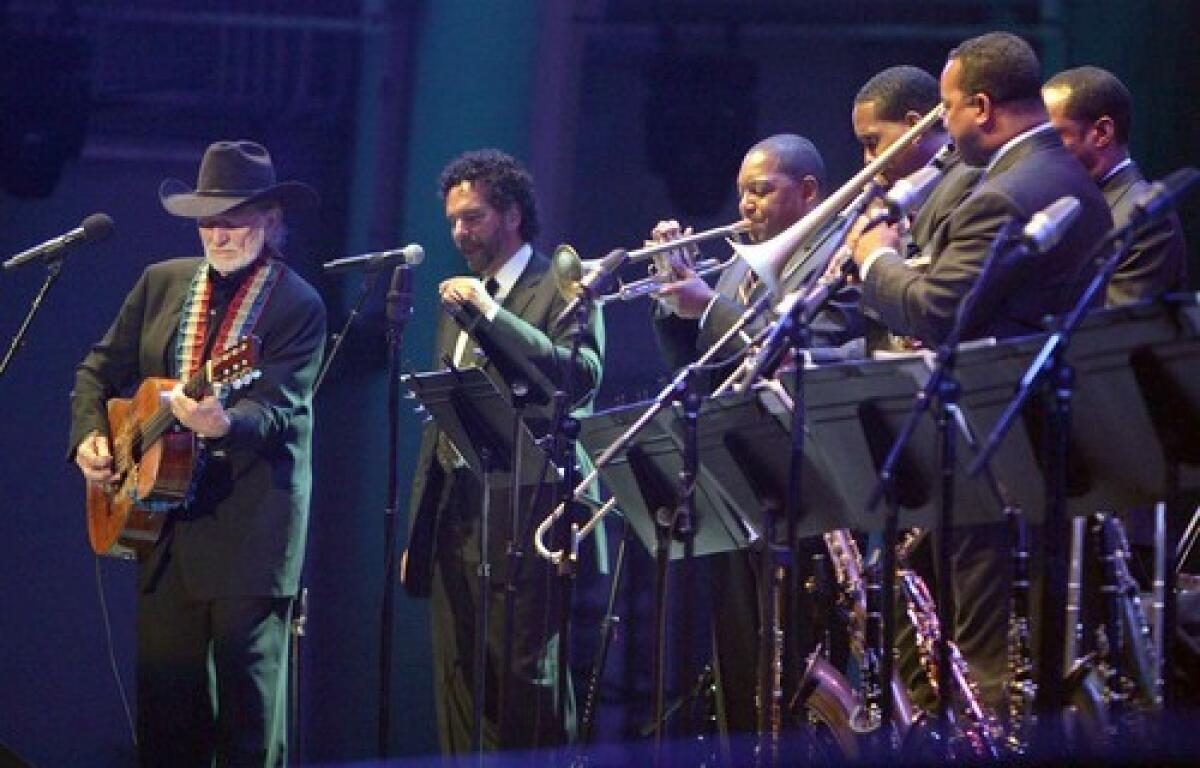Wynton Marsalis and the Lincoln Center Jazz Orchestra at the Hollywood Bowl

Wynton Marsalis describes the big jazz band as âthe American orchestra.â Itâs an intriguing and, in many ways, definitive identification of the instrumental collective that has been a foundation ensemble of American jazz and popular music for more than 80 years. Like the classical orchestra, it is an ensemble that has served as the expressive musical vehicle for a particular culture -- in this case, American rather than European. The performance by Marsalisâ 15-piece Lincoln Center Jazz Orchestra at the Hollywood Bowl on Wednesday night was a dynamic, living color display of the multifaceted meaning of his description.
The orchestraâs opening two selections, one with classical roots, the other based on a traditional song, immediately revealed a tiny sampling of the vast, far too rarely heard, existing repertoire of music available for the American orchestraâs instrumentation of trumpets, trombones, saxophones and rhythm section. George Gershwinâs âRhapsody in Blue,â performed by the orchestra in a richly atmospheric arrangement by Billy Strayhorn, was a stunning expansion of the jazz elements coursing through the original, with the dark, evocative baritone saxophone of Joe Temperley leading the way. Oliver Nelsonâs jaunty take on the traditional âDown by the Riversideâ came alive via a rhythmically energized, deceptively complex jazz development of a familiar tune. As in the âRhapsody,â the collective passages of âRiversideâ opened up for expansive soloing, highlighted by the back-and-forth duo improvisation from trumpeters Sean Jones and Marcus Printup.
A pair of new compositions by saxophonist Ted Nash added a different perspective -- the American orchestraâs potential as the vehicle for new works. Two movements from Nashâs year-old seven-part suite -- âPortrait in Seven Shadesâ -- offered pieces inspired by Salvador Dali and Pablo Picasso. Each had its impressionistic aspects, the formerâs slippery passages and airy dissonances suggesting Daliâs surrealistic landscapes and limpid images, the latter filled with the jarring clashes of Cubist angles and colors.
Two more American orchestra perspectives were added with Benny Carterâs lovely âAgain and Again,â a gorgeously intimate jazz ballad featuring the lyrical alto saxophone playing of Sherman Irby and -- in direct contrast -- a high-spirited segment from Marsalisâ first jazz Mass, âAbyssinian 200.â
But the most unpredictable expression of American orchestra versatility arrived with the appearance of Willie Nelson. In an unexpected example of serendipity, the cancellation of Natalie Coleâs performance opened the way for a live presentation of the musical encounter between Marsalis and Nelson chronicled on their just-released CD, âTwo Men With the Blues.â
Thatâs an unlikely pairing, and its success was largely based upon the integration of Nelson into the flawless backing of various Lincoln Center orchestra ensembles. In five songs from the album, reaching from the irresistible blues of âMy Bucketâs Got a Hole In Itâ and âCaldoniaâ to the sophistication of âStardust,â Nelsonâs timeless, beyond-style vocals were framed by a series of evocative combinations, from the full orchestra to a New Orleans-style small band. The setâs peak was Marsalisâ Louis Armstrong-inspired solo on âStardust.â
The musically diverse evening opened with a busy set by virtuosic young pianist Eldar Djangirov, who offered his best playing in those passages that allowed some imaginative lyricism to sneak past his flying fingers.
More to Read
The biggest entertainment stories
Get our big stories about Hollywood, film, television, music, arts, culture and more right in your inbox as soon as they publish.
You may occasionally receive promotional content from the Los Angeles Times.









